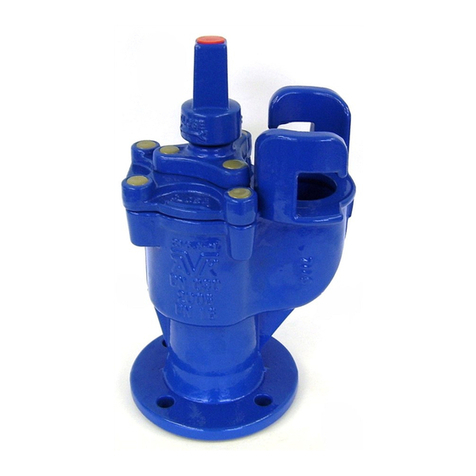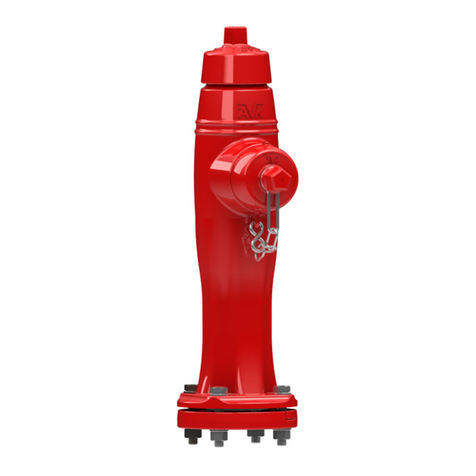
page 2
Item No. Description Material
F1 Weathershield Bolt 304 Stainless steel
F2 Weathershield Grey Iron, ASTM126, Class “B”
F3 Lockplate Bolt 304 Stainless steel
F4 Lock Plate 304 Stainless steel
F5 Inner Thrust Nut O-ring NBR
F6 Thrust Nut Copper Alloy
F7 Outer Thrust Nut O-ring NBR
F8 Anti Friction Washer Nylon
F9 Lubrication Hole Seal NBR
F10 Operating Nut Copper Alloy
F11 Stop Nut Zinc plated steel
F12 Bonnet Bolt Zinc plate, 304, 316 Stainless steel
F13 Bonnet Washer Zinc plate, 304, 316 Stainless steel
F14 Bonnet Ductile Iron, ASTM A536
F15 Stem Seal O-rings NBR
F16 Upper Stem Rod 304 Stainless steel, Epoxy coated steel
F17 Barrel Gasket NBR with stainless steel insert
F18 Bonnet Nut Zinc plate, 304, 316 Stainless steel
F19 Hose Nozzle Cap Grey Iron, ASTM126, Class “B”
F20 Hose Nozzle Copper Alloy
F21 Hose Nozzle Cap Gasket NBR
F22 Hose Nozzle O-ring NBR
F23** Set Screw - (Nozzle) 304 Stainless steel
F24* Chain Assembly Zinc Plated Steel
F25 Pumper Nozzle O-ring NBR
F26 Pumper Nozzle Copper Alloy
F27 Pumper Cap Gasket NBR
F28 Pumper Cap Grey Iron, ASTM126, Class “B”
F29 Nozzle Section Ductile Iron, ASTM A536
F30 Nozzle Section Bolt Zinc plate, 304, 316 Stainless steel
F31 Nozzle Section Washer 304 Stainless steel
F32 Lock Ring 304 Stainless steel
F33 Breakable Flange Ductile Iron, ASTM A536
F34 Nozzle Section Nut 304 Stainless steel
F35* Upper Barrel Ductile Iron, ASTM A536
F36 Coupler Pin 420 Stainless steel
F37 Breakable Stem Rod Coupling 431 Stainless steel
F38 Spring Pin 304 Stainless steel
F41 Lower Stem Rod Mild Steel, 304 Stainless steel
F42* Extension Coupling 304 Stainless steel
F43* Extension Barrel Ductile Iron, ASTM A536
F44 Upper.Extension Barrel Bolt Zinc plate, 304, 316 Stainless steel
F45 N/A
F46 Standpipe Flange Ductile Iron, ASTM A536
F47* Monitor Elbow Ductile Iron, ASTM A536
F48* Extension Stem Rod Mild Steel, 304 Stainless steel
F49 Lower Barrel Ductile Iron, ASTM A536
F50 Lower Barrel O-ring NBR
F51 Valve Seat Ring Copper Alloy
F52 N/A
F53 Valve Seat O-ring NBR
F54 Drain Ring Copper Alloy
F55 Brass Plug Copper Alloy
F56 Brass Fitting Copper Alloy
F58 N/A
F60 Main Valve Retaining Pin 420 Stainless steel
F61 Main Valve EPDM, Encapsulated Ductile Iron
F62 Base Gasket NBR
F63* Straight Inlet Ductile Iron, ASTM A536
F65 N/A
F66 N/A
F67 Base Ductile Iron, ASTM A536
F68 N/A
F69*** Thrust Bearing Race Hardened Steel
F70*** Thrust Bearing Hardened Steel
F71* Modern Nozzle Section Bolt Zinc plate, 304, 316 Stainless steel
F72* Base Gasket - Specify type NBR
F73* Storz Cap O-ring EPDM
F74* Cap/Cable Assembly
F75 Zerk Fitting Case Hardened Steel, Zinc Plated
F88 Main Valve Retaining Pin Washer 304 Stainless steel
F90* Hose Nozzle Position Clip 300 Series Stainless
F91* Pumper Nozzle Position Clip 300 Series Stainless
F92* Inner Storz Cap O-ring NBR
F93* Storz Adaptor Copper Alloy
F94 Bury Tag Aluminum
F95 Extension Bury Tag Aluminum
* Not Shown in Exploded Parts Breakdown
** As of July 2015, secondary Set Screws were added to
all dry barrel nozzle outlets
*** As of Dec. 2018, the upper Anti Friction Washer has been
replaced with a 3 piece roller bearing assembly comprised of 2,
F69 Thrust Bearing Races and 1, F70 Thrust Bearing.































